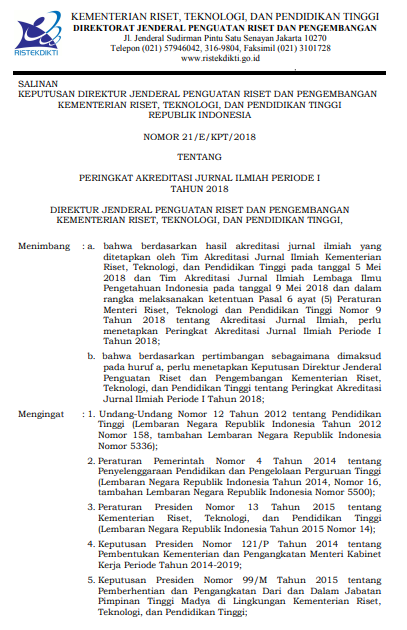HUMANITARIAN LAW PRINCIPLES ON THE USE OF DRONES IN INTERNAL ARMED CONFLICT: AN INDONESIAN NATIONAL LAW PERSPECTIVE
Abstract
State practice shows the increase use of drones in internal armed conflict. The discussion is conducted to answer whether national law adopts humanitarian law principles on the use of drones in internal armed conflict. Qualitative analysis is conducted with primary and secondary legal materials. The Regulation of the Minister of Transportation No. 90/2015 on Unmanned Aircraft Operation Control in airspace served by Indonesia and Minister of Defense Regulation No. 26/2016 on the use of drones for defense and security affairs does not contain the distinction principle, proportionality principle and precautionary principle. It is interpreted that the clauses in both rules on licensing, airspace classification and its activities can be used as a first step in intelligence gathering which will be useful in applying the distinction principle at the time of internal armed conflict. It is necessary to formulate the rules in detail in Military Manual that adopt humanitarian law principles.
Keywords: drone, humanitarian law principles, Indonesian legislation
Full Text:
PDF View
References
Alston, Philip. “Study on Targeted Killings”. UN Doc. A/HRC/14/24/Add.6. May 28. 2010;
Federico Sperotto. “The Use of Drones in Targe-ted Killing Operations”. Available on website https://www.researchgate.net/ publication/281833794_The_Use_of_Drones_in_Targeted_Killing_Operations. Accessed on August 25th. 2018;
Backstrom, Alan and Ian Henderson. “New cap-abilities in warfare: an overview of contemporary technological develop-ments and the associated legal and en-gineering issues in Article 36 weapons re-views”. International Review of the Red Cross. Vol. 94 No. 886. Summer 2012. Pp.483-514. DOI: 10.1017/S181638311200 0707;
Biro Informasi dan Hukum. “Kementerian Perta-hanan Terima 15 Produk Program Pe-ngembangan Teknologi Industri Pertahan-an”. Kemenko Kemaritiman RI. Available on website https://maritim.go.id/kemen terian-pertahanan-terima-15-produk-pro gram-pengembangan-teknologi-industri-pertahanan/. accessed on August 25th. 2018;
Blank, Laurie R and Benjamin R Farley. “Charac terizing US Operations in Pakistan: Is the United States engaged in an Armed Con-flict?”. Fordham Internatioal Law Jour-nal. Vol. 34 Issue 2. 2011. Pp. 151-189;
Boyle, Michael J. “The legal and ethical im-plications of drone warfare”. The Inter-national Journal of Human Rights. Vol. 19. No. 2. 2015. Pp. 105-126. DOI: 10.10 80/13642987.2014.991210;
BPPT. November 02nd. 2016. “BPPT Pamer Drone Sriti dan Swamp Boat pada Indo Defence 2016”. Available on website https:// www.bppt.go.id/teknologi-hankam-trans portasi-manufakturing/2770-bppt-pamer-drone-dan-swamp-boat-pada-indo-defence-2016. Accessed on August 25th. 2018;
Brooke-Holland. Louisa. 2015. Overview of mil-itary drones used by the UK Armed Forces, House of Commons Library: Brief-ing Paper;
Cameroon, PJ. “The Limitations on Methods and Means of Warfare”. Australian Yearbook of International Law. Vol. 9. 1980. Pp. 247-261;
Casey-Maslen, Stuart. “Pandora’s box? Drone strikes under jus ad bellum. jus in bello. and international human rights law”. In-ternational Review of the Red Cross. Vol. 94 No. 886. Summer 2012. Pp. 616-623. DOI: 10.1017/S1816383113000118;
Clearly, Zachary. “Re-evaluating the Efficacy of Targeted Killing”. The Illini Journal of In-ternational Security. Vol. 4 No. 1. 2018. Pp. 1-8.
Daoust, Isabelle. Robin Coupland and Rikke Ishoey. “New wars. new weapons? The obligation of States to assess the legality of means and methods of warfare”. Inter-national Review of the Red Cross. Vol. 84 No. 846. June 2002. Pp. 347-352;
Detik, Friday 31 July 2015. https://news.detik. com/berita/2980580/ini-penjelasan-drone-pesawat-tanpa-awak-yang-diatur-kemenhub. Accessed on August 25th. 2018;
Dillow, Clay. February 12th. 2016. “All of These Countries Now Have Armed Drones”. For-tune. Available on website http://www. fortune.com/2016/02/12/these-coun tries-have-armed-drones/. Accessed on August 25th. 2018;
DOD Dictionary of Military and Associated Terms (As of June 2018). available on website http://www.jcs.mil/Portals/36/ Documents/Doctrine/pubs/dictionary.pdf?ver=2018-07-25-091749-087. accessed on August 25th. 2018;
Heyns, Christof. Dapo Akende. Lawrence Hill-Cawthorne and Thompson Chengeta. “The International Law Framework Regulating the Use of Drones”. International & Com-parative Law Quarterly. Vol. 65 Issue 4. October 2016. Pp. 791-827;
Holman, Brett. August 22nd. 2009. “The first air bomb: Venice. 15 July 1849”. Available on website: https://airminded.org/2009/ 08/22/the-first-air-bomb-venice-15-july-1849/. Accessed on August 25th. 2018;
Human Rights Watch. 2012. Losing Humanity. The Case against Killer Robots;
International Criminal Tribunal for Yugoslavia. Prosecutor v. Tadic. Decision on the De-fence Motion for Interlocutory Appeal on Jurisdiction. Appeals Chamber. Case IT-94-1. October 2nd. 1995. para (127);
International Military Tribunal at Nuremberg. “Judgment and Sentences”. American Journal of International Law. Vol. 41. Oct 1. 1947. Pp. 248-249;
Kalshoven, Frits and Liesbeth Zegveld. 2001. Constraints on the Waging of War. An Introduction to International Humanit-arian Law. 3rd Edition, Geneve: ICRC.
Kolanowski, Stephane. “Drones Strike in Armed Conflict under International Humanitarian Law”. Royal Higher Institute for Defence, Brussels, 6 February 2014, pp. 3. Avail-able on website http://www.irsd.be/ website/images/images/Activites/Colloques/presentation/2014-02-06/kolanowski. pdf, accessed on August 25th, 2018;
Kreps, Sarah and John Kaag. “The Use of Un-manned Aerial Vehicles in Contemporary Conflict: A Legal and Ethical Analysis”. Polity. Vol. 44 No. 2. April 2012. Pp. 260-285;
Kreuzer, Michael P. “RPAs and Non-International Conflict–A Strategic/Legal Assessment”. Cardozo Law Review. Vol. 36 Issue 2. 2014. Pp. 691-695;
Labrador, Dalia D. “Controversy: New Technol-ogy for War: The Legality of Drone-Based Targeted Killings under International Law”. Chicago-Kent Journal of Interna-tional and Comparative Law. Vol. 16. Is-sue 2. Pp.1-14.
Lawand, Kathleen. “Reviewing the legality of new weapons. means and methods of warfare”. International Review of the Red Cross. Vol. 88. Number 864. Dec-ember 2006. Pp. 925-930. DOI: 10.1017/ S1816383107000884;
Lewis, Michael W. “Drones and the Boundaries of the Battlefield”. Texas International Law Journal. Vol. 47 Issue 2. 2012. Pp. 294-314;
Lotrionte, Catherine. “Targeted Killings by Drones: A Domestic and International Le-gal Framework”. Journal of International and Comparative Law. Vol. 3 Issue 1. 2012. Pp. 19-70;
Marboen, Ade P. “Ryamizard Ryacudu saksikan uji coba pesawat tanpa awak”. Antara News. July 27th. 2017. Available on web-site https://www.antaranews.com/beri ta/642968/ryamizard-ryacudu-saksikan-uji-coba-pesawat-tanpa-awak. Accessed on August 25th. 2018.
Martin, Craig. “A Means-Methods Paradox and the Legality of Drone Strikes in Armed Conflict”. International Journal of Human Rights. Vol. 19 Issue 2. 2015. Pp. 142-175. DOI: 10.1080/13642987.2014.998864;
Prisacariu, Vasile. “The History and the Evolu-tion of UAVs from the Beginning till the 70s”. Journal of Defense Resources Man-agement. Vol. 8 Issue 1 (14). 2017. Pp. 181-189;
Queguiner, Jean-François. “Precautions under the law governing the conduct of hostil-ities”. International Review of the Red Cross. Vol. 88 No. 864. December 2006. Pp. 793-821. DOI: 10.1017/S181638310700 0872;
Qureshi, Waseem Ahmad. “The Legality and Conduct of Drone Attack”. Notre Dame Journal of International & Comparative Law. Vol. 7 Issue 2. 2017. Pp. 91-106;
Sadat, Leila Nadya. “America’s Drone Wars”. Case Western Reserve Journal of Interna-tional Law. Vol. 45. 2012. Pp. 215-234;
Sandoz, Yves et.al. eds. 1987. Commentary to the Additional Protocols of 8 June 1977 to the Geneva Conventions of 12 August 1949, Geneve: ICRC;
Sehrawat, Vivek. “Legal Status of Drones under LOAC and International Law”. Penn State Journal of Law & International Affairs. Vol. 5 Issue 1. April 2017. Pp. 166-206;
Tempo. “TNI AD Bikin Pesawat Tanpa Awak Super Drone”. April 8th. 2014. Available on website https://nasional.tempo.co/ read/568727/tni-ad-bikin-pesawat-tanpa-awak-super-drone. Accessed on August 25th, 2018.
UNGA Report A/68/389. September 18th . 2013. para (29-40);
UNGA Res. 2444 (XXIII). Respect for Human Rights in Armed Conflict. December 19th. 1968. para (110);
Uweh, Atip Latipulhayat and Neni Ruhaeni. “In Search of Remotely Piloted Aircraft Regu-lations. State Practices and International Law Perspectives: What Indonesia can Learn?”. Brawijaya Law Journal. Vol. 5 No. 1. April 2018. Pp. 54-73. DOI: 10.21 776/ub.blj.2018.005.01.05;
Walker, Jon. September 1st. 2017. “Unmanned Aerial Vehicles (UAVs)–Comparing the USA. Israel. and China”. Available on website https://www.techemergence. com/unmanned-aerial-vehicles-uavs/. Ac-cessed on August 25th. 2018;
Warsud, Agus. Dian Ramdhani and Arvin. “Per-caya Diri Membangun Drone Tempur”. Ko-ran Sindo. 6 Agustus 2017. Available on website http://koran-sindo.com/page/ news/2017-0806/0/0/Percaya_Diri_Mem bangun_Drone_Tempur. accessed on August 25th. 2018.
Wuschka, Sebastian. “The Use of Combat Drones in Current Conflicts–A Legal Issue or a Political Problem?”. Goettingen Journal of International Law. Vol. 3 Issue 3. 2011. Pp. 892-905.
DOI: http://dx.doi.org/10.20884/1.jdh.2018.18.3.2116
Refbacks
- There are currently no refbacks.
JURNAL DINAMIKA HUKUM Indexed by :
 | Jurnal Dinamika Hukum | |
| Faculty of Law, Universitas Jenderal Soedirman | Copyright of Jurnal Dinamika Hukum | |
| Yustisia IV Building, Law Journal Center | ISSN 2407-6562 (Online) ISSN 1410-0797 (Print) | |
| Purwokerto, Central Java, Indonesia, 53122 | JDH is licensed under a Creative Commons Attribution 4.0 International License | |






